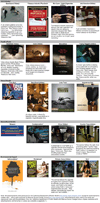Testing antismoking messages for Air Force trainees
- PMID: 26482786
- PMCID: PMC4837096
- DOI: 10.1136/tobaccocontrol-2015-052477
Testing antismoking messages for Air Force trainees
Abstract
Introduction: Young adults in the military are aggressively targeted by tobacco companies and are at high risk of tobacco use. Existing antismoking advertisements developed for the general population might be effective in educating young adults in the military. This study evaluated the effects of different themes of existing antismoking advertisements on perceived harm and intentions to use cigarettes and other tobacco products among Air Force trainees.
Methods: In a pretest-post-test experiment, 782 Airmen were randomised to view antismoking advertisements in 1 of 6 conditions: anti-industry, health effects+anti-industry, sexual health, secondhand smoke, environment+anti-industry or control. We assessed the effect of different conditions on changes in perceived harm and intentions to use cigarettes, electronic cigarettes, smokeless tobacco, hookah and cigarillos from pretest to post-test with multivariable linear regression models (perceived harm) and zero-inflated Poisson regression model (intentions).
Results: Antismoking advertisements increased perceived harm of various tobacco products and reduced intentions to use. Advertisements featuring negative effects of tobacco on health and sexual performance coupled with revealing tobacco industry manipulations had the most consistent pattern of effects on perceived harm and intentions.
Conclusions: Antismoking advertisements produced for the general public might also be effective with a young adult military population and could have spillover effects on perceptions of harm and intentions to use other tobacco products besides cigarettes. Existing antismoking advertising may be a cost-effective tool to educate young adults in the military.
Keywords: Advertising and Promotion; Media; Non-cigarette tobacco products; Priority/special populations.
Published by the BMJ Publishing Group Limited. For permission to use (where not already granted under a licence) please go to http://www.bmj.com/company/products-services/rights-and-licensing/.
Conflict of interest statement
The authors have no conflicts of interest
Figures


Similar articles
-
Association of Exposure to Court-Ordered Tobacco Industry Antismoking Advertisements With Intentions and Attempts to Quit Smoking Among US Adults.JAMA Netw Open. 2020 Jul 1;3(7):e209504. doi: 10.1001/jamanetworkopen.2020.9504. JAMA Netw Open. 2020. PMID: 32633765 Free PMC article.
-
Efficacy of a Brief Tobacco Intervention for Tobacco and Nicotine Containing Product Use in the US Air Force.Nicotine Tob Res. 2016 May;18(5):1142-9. doi: 10.1093/ntr/ntv242. Epub 2015 Oct 27. Nicotine Tob Res. 2016. PMID: 26508394 Free PMC article.
-
Testing messages about comparative risk of electronic cigarettes and combusted cigarettes.Tob Control. 2019 Jul;28(4):440-448. doi: 10.1136/tobaccocontrol-2018-054404. Epub 2018 Aug 13. Tob Control. 2019. PMID: 30104408 Free PMC article.
-
Tobacco control in Vietnam.Public Health. 2013 Feb;127(2):109-18. doi: 10.1016/j.puhe.2012.11.012. Epub 2013 Jan 22. Public Health. 2013. PMID: 23352122 Review.
-
Effect of smokeless tobacco product marketing and use on population harm from tobacco use policy perspective for tobacco-risk reduction.Am J Prev Med. 2007 Dec;33(6 Suppl):S379-86. doi: 10.1016/j.amepre.2007.09.015. Am J Prev Med. 2007. PMID: 18021913 Review.
Cited by
-
The comparative effectiveness of two brief tobacco interventions in the U.S. Air Force: Perceived harm and intentions-to-use of tobacco products.Tob Induc Dis. 2018 Jun 1;16:26. doi: 10.18332/tid/87142. eCollection 2018. Tob Induc Dis. 2018. PMID: 31516426 Free PMC article.
-
An experimental study of messages communicating potential harms of electronic cigarettes.PLoS One. 2020 Oct 21;15(10):e0240611. doi: 10.1371/journal.pone.0240611. eCollection 2020. PLoS One. 2020. PMID: 33085686 Free PMC article.
-
Overview of Electronic Nicotine Delivery Systems: A Systematic Review.Am J Prev Med. 2017 Feb;52(2):e33-e66. doi: 10.1016/j.amepre.2016.10.036. Epub 2016 Nov 30. Am J Prev Med. 2017. PMID: 27914771 Free PMC article.
-
Using the Socio-ecological Model to Explore Facilitators and Deterrents of Tobacco Use Among Airmen in Technical Training.Mil Med. 2022 Aug 25;187(9-10):e1160-e1168. doi: 10.1093/milmed/usab075. Mil Med. 2022. PMID: 33637975 Free PMC article.
-
Feeling Hopeful Motivates Change: Emotional Responses to Messages Communicating Comparative Risk of Electronic Cigarettes and Combusted Cigarettes.Health Educ Behav. 2019 Jun;46(3):471-483. doi: 10.1177/1090198118825236. Epub 2019 Feb 10. Health Educ Behav. 2019. PMID: 30741001 Free PMC article. Clinical Trial.
References
-
- Substance Abuse and Mental Health Services Administration. Results From the 2013 National Survey on Drug Use and Health: Detailed Tables. Rockville, MD: Substance Abuse and Mental Health Services Administration, U.S. Department of Health and Human Services; 2013.
-
- Adelman W. Trajectories, health, safety, and well-being of young adults in the military. IOM/NRC Workshop on Improving the Health, Safety, and Well-Being of Young Adults; Washington, DC. 2013.
Publication types
MeSH terms
Grants and funding
LinkOut - more resources
Full Text Sources
Other Literature Sources
Medical
